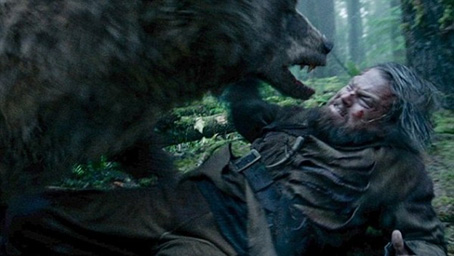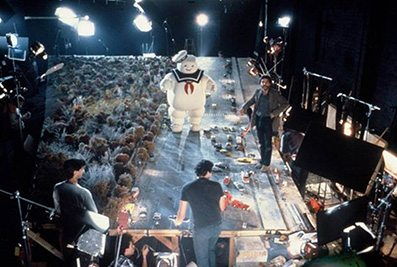"I think audiences have hit the wall with CGI and
special effects. They have seen so many over-the-top
events that they can't suspend disbelief." |
Sylvester Stallone |
Early in the New Year, Leonardo DiCaprio will get attacked by a bear and not raped by one as social media has been suggesting. It is one of the sequences earmarked by the marketing department from Birdman director Alejandro G. Iñárritu's latest offering, The Revenant. With snippets of information gleaned from interviews, we are told that wires were involved pulling and dragging DiCaprio all over the forest floor (think of Susan Backlinie's ordeal as the first victim in Jaws). But I can't help but notice the complete absence of any mention of how the bear in the bear attack was realised. The sequence is astounding for its 'in your face' reality right down to the lens being steamed up by bear breath. You are never doubtful of any aspect of its realism while watching the sequence which is as it always should be. But for some reason no one is talking about the elephant in the room, or in this case, the bear in the forest.

When Tom Cruise had the faintly silly idea of being attached to the outside of an aeroplane taking off for last summer's Mission Impossible: Rogue Nation, the marketing went into overdrive. Isn't he brave? Amazing! Wow etc. Put it on the poster! We were treated to featurettes, endless interviews and blow-by-blow accounts of how this stunt was performed. The one thing Paramount didn't mention was that the stunt wasn't performed for the movie. It was performed for the marketing department. In order for the tent pole blockbuster-to-be to stand out from the crowd, it must now strive or at the very least pretend to be 'real'. The new black is 'in camera' effects, what we once used to call special effects, effects done on the day by fearless stunt performers, hugely talented puppeteers, animatronic builders and sleight of lens magicians. There is a wonderful etymological irony in the word for this kind of magic... Presdigitation. Before digital... Cruise's bravery and the shot's worth was undercut by two undeniable truths. Firstly, this would have been the easiest shot to get with green screen and a giant fan and we would not have been able to tell the difference. Or would we? Secondly, as soon as Simon Pegg gets the right door open and Cruise is hurled inside the cargo area, it is so clearly a VFX heavy piece of animation, it renders the whole fuss about 'reality' utterly moot.
Breaking records all over the world (and still to open in the world's third largest market, China) is a little film called Star Wars: The Force Awakens. Director Abrams and his crew are falling all over themselves promoting the excellence of the work done by their special effects artists and downplaying the role of the computer in the film's general aspect. I suspect this is a way of creating an identity more closely linked to Lucas' original movie rather than be associated with and therefore tainted by the prequels' all too digitally drenched brush. Abrams shot on 35mm film, the cinematic equivalent of me writing this review with a quill. But if you think for one second that with a few exceptions, all the shots in Star Wars are done for real, then the marketing smokescreen is strong with this one. Even the most naïve cinemagoer these days must be aware that computers are heavily involved in every film's making even something as seemingly CG averse as The Lady In The Van. Most movies are shot digitally these days and post produced in the very heart of the digital playpen. Digital removal and replacement is as common a facet of filmmaking these days as using a camera. The idea of analogue film production must seem to most like some weird relic from the Victorian age.
I've had a love affair with special effects ever since I read and re-read John Brosnan's Movie Magic in the 70s and I am absolutely intrigued to discover that audiences seem to be tiring of computer generated imagery so much so that filmmakers are shifting back to doing as much as they can in front of the lens. But I'm reminded of that great quote by some Hollywood agent, "Sincerity is the key in L.A. If you can fake that, you've got it made..." Film and TV production will never go back to purely analogue techniques. Even if there is precious little actual digital shot-building in your movie, you can bet your last dollar that it was graded on a state of the art digital platform. Our rough, limited analogue palette has expanded to the point where we would be foolish to go back to older techniques even if half the marketing departments of the world want us to believe otherwise. Of course, the bear that attacks DiCaprio is not a real bear and neither is it a man in a suit. It is a stunningly realised computer generated bear that is astonishingly realistic. Of course the filmmakers want to immerse you in their stories and not have you disengaged wondering how something was done. DVD Extras did a lot of damage to the mystery of filmmaking. Your every day punter now probably knows enough to blithely wave their hand at the screen showing something extraordinary like L.A. in ruins sliding into the sea in 2012 and saying "It's just CG." So to make up for this, we're being asked to believe that filmmakers in 2016 and beyond are going back to basics... Yeah, right. There's a bell on the other one.

But here's the kicker. While CG has developed at warp speed in the last twenty years to the point where I can no longer tell the difference between a real and digital bear (it astounds me just typing those words), so has the art and craft of the special effects artist 'sans souris' as it were. As technology makes things better, animatronics become more sophisticated, more believable and 'in-camera' effects, explosions and scale models claw back their aura of mystery that used to surround the techniques used to suspend our disbelief. In the one true special effects magazine, Cinefex, one that's been in print since 1980, you suddenly hit a wall of 'behind the scenes' FX photos in the mid to late 90s that were essentially men and women at work stations. At least practical effects give you those stunning "Are you kidding me?" photos. Once you've seen the Stay Puft Marshmallow Man rampaging on a miniature New York street, you see the world (and its wonderfully imaginative special effects artists) in a new and dazzling light. I was also stunned to realise that the Bat Mobile crashing into a garbage truck in The Dark Knight was achieved using miniatures. Christopher Nolan is famously pro-practical but his movies still need a great deal of digital embellishment but to get the biggest bang for your buck (what a charming phrase...), it's the subtle use of digital effects, corrections, removals etc. that the audience can never be aware of. How can people promote visual effects artists at awards season if you cannot even tell what they've worked on? There is a lovely story about the Academy not acknowledging the make up work of Stuart Freeborn on Kubrick's 2001 because they believed that the apes were real...

I will continue to be fascinated by the art of special effects even if the ubiquity of CG has tainted said art. The people who build things in reality to be photographed 'live', the people that solve practical problems and find sometimes inspired solutions deserve as much recognition as those legions of FX artists who recently came together united against the cavalier attitude studios have towards those that perform these miracles. I just wish mainstream Hollywood would put as much care into the screenplays and ideas from which movies are made as these extraordinary technicians and craftspeople pour into their work.
|